

A Guide to Transformational Change Management. Want to get your organization fit for the future working landscape?
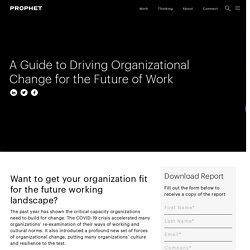
The past year has shown the critical capacity organizations need to build for change. The COVID-19 crisis accelerated many organizations’ re-examination of their ways of working and cultural norms. Report: A Guide to Organizational Change Fitness for the New Future of Work. Why Your Organization Needs Enterprise Change Management. Project teams today increasingly recognize the need to manage the people side of change on individual projects, but that isn’t enough for some organizations.

11 Elements of Successful Organizational Change Capability. Over the last few decades, the discipline of change management has evolved from ad hoc approaches into a sophisticated discipline driven by structure, rigor, process and deliverables.
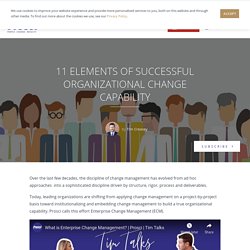
Why Strategic Alignment is Essential to Enterprise Change Planning. Why should you bother with strategic alignment when you’re building change management capability?
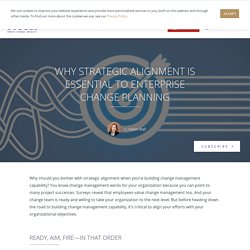
You know change management works for your organization because you can point to many project successes. Surveys reveal that employees value change management too. And your change team is ready and willing to take your organization to the next level. But before heading down the road to building change management capability, it’s critical to align your efforts with your organizational objectives. Ready, Aim, Fire—in That Order. The Change Management Function of the C-Suite.
C-suite executives tend to be good at launching major change initiatives.
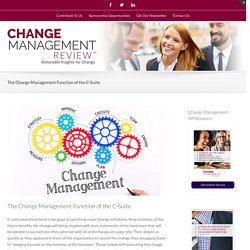
Rosy promises of the future benefits the change will bring coupled with stoic statements of the hard work that will be needed to succeed are often adorned with all of the hoopla of a pep rally. Then, almost as quickly as they appeared in front of the organization to launch the change, they disappear, back to “keeping focused on the business of the business.” Those tasked with executing the change (designated change sponsors and change practitioners) are expected to carry the change through over the coming months, and even years, only engaging the leadership team with periodic updates and (if needed) crisis management.
Why you’ve got to put your business portfolio on the move. Every CEO will ask, at least once, “Which business should this company be in?”

But the best know it can’t be a one-time question. They keep asking, and change their answer over time. These CEOs put their company’s portfolio of businesses on the move—and outperformance tends to follow. The reverse largely holds true as well. CEOs who rarely ask the question end up with a static portfolio, and serially underperform. Why Agile organizations need more Agile Change Management during COVID-19. The past year has been the most challenging in living memory, from both a personal and business perspective.
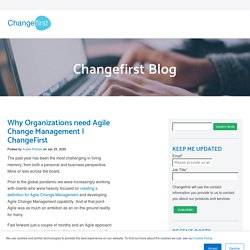
More or less across the board. Prior to the global pandemic we were increasingly working with clients who were heavily focused on creating a definition for Agile Change Management and developing Agile Change Management capability. And at that point Agile was as much an ambition as an on-the ground reality for many. Fast forward just a couple of months and an Agile approach is no longer just a wishlist item. Operational excellence for management of change by John Crawford. Infographic - Project change planning for post-Covid. On the complexity of change... Managing Change in Uncertain Times with Jason Little. Regulatory Change Management Lessons From change Management.
While regulatory change management and enterprise change management may be different domains, there is a lot that regulatory change managers can learn from enterprise change management.

The basics of both remain the same, even if regulatory change is a bit more complicated to manage. Identify the nature of change In addition to failures related to lack of support, 70% of change projects fail because they are not managed with an adapted approach. In other words, we often think that all change projects are the same and can be done in the same way, but that is far from the case. Indeed, each change must be treated in a personalized way according to its nature and the populations impacted, because, by definition, the change is frightening and creates frustration. The same goes for regulatory changes. Build an action plan. 100 projects at once. Leading Enterprise Change to Scale Business Agility. How to Manage the Waves of Change. Managing change today is a lot like surfing.

Just like waves, change never stops. No two waves are exactly alike, but there are patterns. Waves form, roll, peak and break. Often, the difference between catching the wave and missing it completely—a fate worse than a wipeout—is how well you understand the characteristics of that particular wave as it forms. Like change, waves can feel pretty scary. To see the opportunity in the waves of change, it is helpful to put them into context.
Thoughts on defining, clarifying, and positioning change management. Science of Organizational Change - Winning the ’20s. De-average Change Strategies Organizational change is often seen as a single type of challenge that calls for a single type of change management in all situations.

Accordingly, most change efforts follow a recipe with common ingredients: for example, centralized program offices, periodic pulse checks, measurement against predefined milestones, and a one-shot process with a clear end date. In reality, there are many types of organizational change that present very different challenges and have very different requirements. Leaders need to de-average organizational transformation into various components and understand the right approach for each. Retrospectives for Organizational Change: An Agile Approach (2019) by Jutta Eckstein. A definition of Enterprise Change Management (ECM) And why digital disruption makes it even more essential for your organization A key theme we kept revisiting in a recent blog series on Agile Change Management was how to implement Enterprise Change Management (ECM) in our organization. It’s a topic that we have written and blogged about quite a bit in recent times, but we wanted to revisit in this new series – particularly as the topics are inextricably linked.
Over the next few weeks we are going to take a closer look at ECM including: Providing a definition of what we believe ECM actually isHow to effectively baseline your ECM strategyWhy leadership is critical to successful implementationHow to kickstart your ECM approachAnd how to roll it out across your organization If you would like to be notified when new posts are available, then you can subscribe here. In this first blog, we are going to take a look at our definition of ECM. The Implementer's Starter Kit: How to Plan and Execute Organizational Change Like a Master, Even If You Aren't One Yet (2018) (Infographic) - How Agile is turning Organizational Change Management on its head.
One of the key topics that is a recurring theme in our discussions with clients right now is how Change Management can support an Agile approach to delivering projects. That set us thinking - and as we sketched out some of our thoughts on the relationship between Agile and Change Management we thought it would be great to lay it out as an infographic which we did below - including looking at the origins for Agile itself, the drivers of Agile and what all of this means for your Change Management Approach going forward. This is part of a new blog series on Agile and we would very much welcome your thoughts on the topic. Please also feel free to share the infographic with your colleagues - and download a copy here.
Download a copy of the infographic. How the C-Suite can sustain Enterprise Change Management capability. At the most mature level of organizational change management, the distinguishing characteristic is that: executive sponsors manage the overall change capacity of the organization. Stop Initiative Overload. Rose Hollister and Michael Watkins, consultants at Genesis Advisers, argue that many companies today are taking on too many initiatives. Each manager might have their own pet projects they want to focus on, but that trickles down to lower level workers dealing with more projects at a time that they can handle, or do well. This episode also offers practical tips for senior-level leaders to truly prioritize the best initiatives at their company — or risk losing some of their top talent. Hollister and Watkins are the authors of the HBR article “Too Many Projects.” Download this podcast SARAH GREEN CARMICHAEL: Welcome to the HBR IdeaCast from Harvard Business Review.
Launching a new initiative is one way a manager can make their mark in a new job – or show their value at a company they’ve been at for years. So it makes sense that more and more managers across industries might be piling on more and more new projects. That’s Rose Hollister. Stop Initiative Overload. Is it possible for organizations to change faster? Hello everybody. It has been a long time since I posted here regularly and I appreciate your patience in staying with me. The last couple of years I have really immersed myself deep in execution of large scale strategy. I do believe that actual practice is the real, and most ruthless, test of our hypotheses. These experiences have caused me to shift my practice quite extensively and you will see that reflected in the new website here and in this content of this blog. The blog remains a learning journal – an exploration and sharing of what I am learning and using.
I hope it has some value for you and if you share these questions I hope that we can converse through the comments. What is the shift all about? Over the years, as I have studied and practiced in this space, I have continued to feel that while we can help organizations do better at individual projects what we typically do is insufficient to create the kinds of shifts that most of our organizations really need.
Change Management for a Fast Moving World. Is Change Agility an Oxymoron? Creating an internal change capability: What’s the right organizational model? Enterprise Change Management Boot Camp. 7 Change Portfolio Management best practices - The Change Compass.